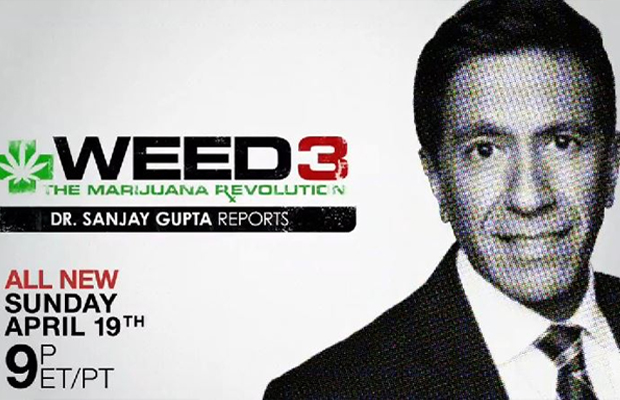Films
Sanjay Gupta’s Weed 3: The Marijuana Revolution
Doctor Sanjay Gupta, CNN’s chief medical correspondent, shed light on the politics encompassing the realm of cannabis during his special report Weed 3: The Marijuana Revolution. The recent installment of this series was historic in the way it delved into the lives of patients who were saved by utilizing medical marijuana. Gupta focused on telling the stories of those who suffered from post traumatic stress disorder (PTSD), unveiling their positively life-changing experiences from using cannabis to treat their symptoms.
About 22 veterans commit suicide every day and if it wasn’t for medical marijuana PTSD sufferer Sean Kiernan could have been one of them. Kiernan found himself almost overdosing on GHB and the PTSD drug Lamictil — the drugs that were supposed to be saving him ended up almost killing him. While he was prescribed dozens of medications to curb his depression and to help with both his sleeplessness and anxiety, most of the pills just made his PTSD symptoms worse. Before turning to cannabis, he almost became another tragic statistic as a victim of a common fate that plagues many U.S. veterans.
Dr. Sue Sisley, who has been treating veterans like Kiernan for decades, found that they were receiving different prescriptions for each of their target PTSD symptoms. According to Sisley, she would see them turn into “zombies,” as only a handful of the drugs on the market proved to be adequate.
Rick Doblin, a researcher with a doctorate from Harvard and founder of the Multidisciplinary Association for Psychedelic Studies (MAPS), has also been researching the effects of medical marijuana on patients for years. Doblin is a staunch supporter of using cannabis to treat the symptoms of PTSD, including nightmares and the plethora of additional symptoms of depression.
“One of the surprising things about marijuana is that it suppresses dream recall. For people that are traumatized and have nightmares, the opportunity to have a good night’s sleep without remembering their nightmares can be fundamentally transformative,” Doblin said.
Doblin added that cannabis focuses a person’s attention to the here and now and can be vital for people who tend to bring trauma from their past into the present.
Sisley was initially a skeptic and needed scientific evidence proving that that marijuana could ease PTSD symptoms. She wanted to study the plant as she would any other medications, believing that doctors had a duty to demand that cannabis went through the same, painstaking research and development as any other drug approved by the FDA.
The process to get their research federally approved was daunting for Sisley and Doblin, as they began their crusade in 2009, applying to the federal government in 2010, only to be rejected. In 2012 they applied again, yet were delayed due to bureaucratic red tape.
While there are many government obstacles to surpass in order for the FDA to approve cannabis grown for research of PTSD, FDA director Douglas Throckmorton told Gupta that the FDA wants it studied efficiently to determine its effectiveness and safety.
A Watershed Moment in Pot Research
Finally in 2014, just four days after Gupta’s special, Weed 2 premiered, Doblin received a call that he and Sisley had to prove their study on marijuana’s effects on PTSD. He attributes this “watershed moment in pot research” to the public perception finally shifting. History was starting to unfold and the revolution in marijuana research was beginning to take a hold.
A single field in Oxford, Miss., the city commonly referred to as “Ole Miss”, became the only place in the United States that scientists could obtain cannabis samples to dispense and research the quality and circulation of the plant from ground to distribution. Before this time the field had not grown marijuana since 2007. According to the farm’s director, Mahmoud ElSohly, there were no real demands or research proposals in the interim. Now, for the first time ever, there is acre upon acre of research-grade marijuana for scientists like Doblin and Sisley to study, seeing if the plant can effectively treat symptoms of PTSD.
The federal government is making strides to push research, increasing pot production 30-fold, from producing 36 pounds to 1400 pounds. The government also anticipates the cannabis to be used to study pain from cancer and epilepsy in addition to the aforementioned PTSD.
In 2014, four months after the PTSD study was approved, Sisley was fired from the University of Arizona, where she had been conducting her study. Her termination made national news. Stripped from all of her work, Sisley felt helpless. Without an office she could not obtain a DEA license to acquire the marijuana. The university claimed that her firing had nothing to do with her involvement in the FDA study.
Kiernan also felt defeated, because although he vaporizes each day to subdue his anger and irritability caused by PTSD, he depended on research such as Sisley’s to determine long-term effects of usage, and proper dosage.
According to Gupta, people with PTSD have a chemical imbalance in their brain. There are too many receptors associated with intense emotions and not enough of the chemical that binds to receptors to restore balance in the brain. Marijuana facilitates this problem.
Harvard’s Staci Gruber is another scientist who has been studying marijuana since the early ’90s. Referred to as the Pot Doc, Gruber met with Gupta years ago when she was studying recreational marijuana’s damage to the brain. Today, she has set her sights on the possible benefits of medical marijuana use. She led a study to examine patients who never used marijuana, observing them before, three months after initiating usage, and three months after that. Patients took cognitive tests throughout the process.
The nature of Gruber’s study was revolutionary. It was the first time that a brain was scanned to chart the changes to the organ after pot use. The results of the study were equally revolutionary. Gruber found that there was no impairment in the brain. On the contrary, there was actually an improvement in the anterior singular cortex, which is the part of the brain that affects decision-making, empathy and emotions. All of which are factors that play a role in PTSD.
Sisley and Gruber’s long wait to study medical marijuana for PTSD research was over. Sisley got word that the Board of Health in Colorado was granting 9 million dollars of surplus tax capital to study medical marijuana. She wanted some of that money to set up a lab. With Kiernan there, proposing a motion to set up the study, the motion was passed. One year after the study was approved, the plants are now fully-grown and ready for Sisley and Doblin to research.
Earlier this year, more history was made as Senators. Cory Booker, Kirsten Gillibrand and Rand Paul introduced a landmark medical marijuana bill that would change the classification of cannabis from Schedule 1 to Schedule 2. The bill would mandate more farms to grow research marijuana and would allow easier access for people such as veterans. They would be able to get prescriptions from a VA hospital for the first time.
Ultimately, those who once stigmatized the world of pot are now diving in, as a revolution is unfurling. This is evidenced by Gupta’s sit-down with President Obama at the end of the special.
“I’m on record as saying that not only do I think carefully prescribed medical use of marijuana may in fact be appropriate and we should follow the science as opposed to ideology on this issue, but I’m also on record as saying that the more we treat some of these issues related to drug abuse from a public-health model and not just from an incarceration model, the better off we’re going to be,” President Obama said.
Did you watch Dr. Gupta’s special on cannabis? Tell us what you think.


























